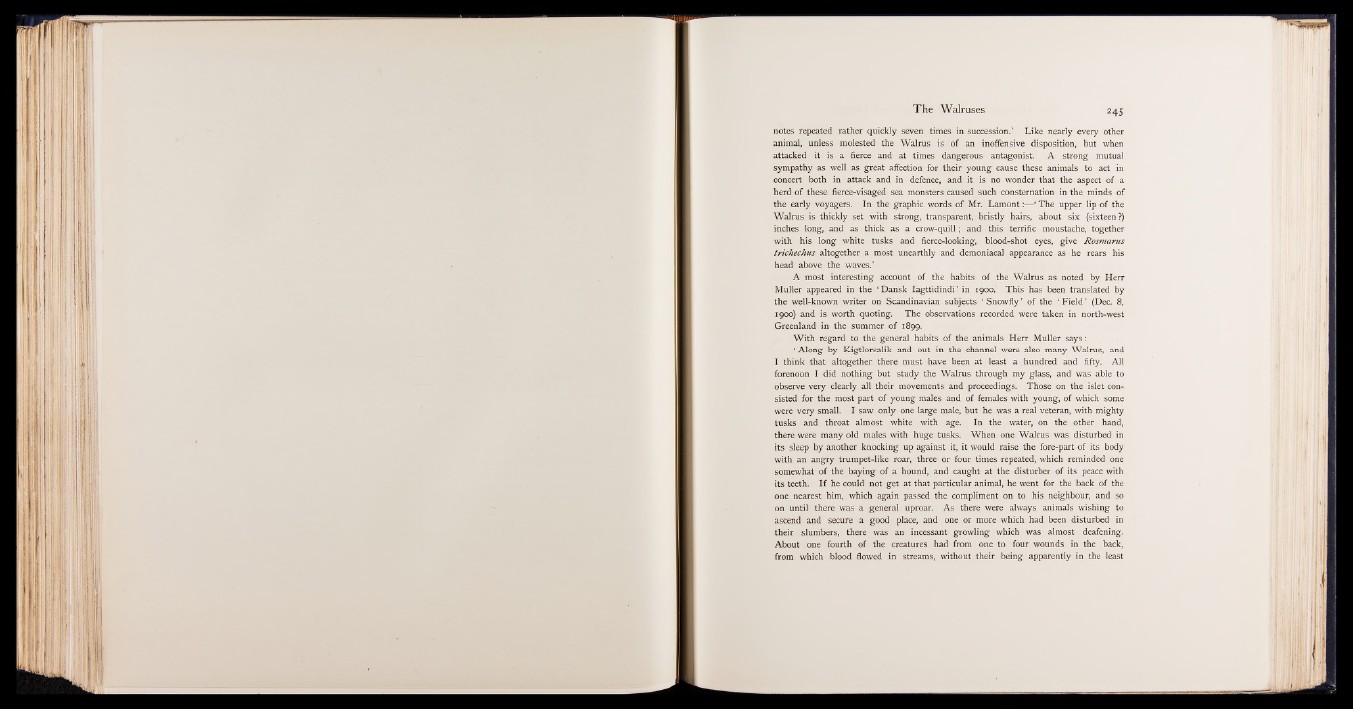
notes repeated rather quickly seven times in succession.’ Like nearly every other
animal, unless molested the Walrus is of an inoffensive disposition, but when
attacked it is a fierce and at times dangerous antagonist. A strong mutual
sympathy as well as great affection for their young cause these animals to act in
concert both in attack and in defence, and it is no wonder that the aspect of a
herd of these fierce-visaged sea monsters caused such consternation in the minds of
the early voyagers. In the graphic words of Mr. Lamont:— ‘ The upper lip of the
Walrus is thickly set with strong, transparent, bristly hairs, about six (sixteen?)
inches long, and as thick as a crow-quill; and this terrific moustache, together
with his long white tusks and fierce-looking, blood-shot eyes, give Rosmarus
trichechus altogether a most unearthly and demoniacal appearance as he rears his
head above the waves.’
A most interesting account of the habits of the Walrus as noted by Herr
Muller appeared in the ‘ Dansk Iagttidindi ’ in 1900. This has been translated by
the well-known writer on Scandinavian subjects ‘ Snowfly ’ of the ‘ Field ’ (Dec. 8,
1900) and is worth quoting. The observations recorded were taken in north-west
Greenland in the summer of 1899.
With regard to the general habits of the animals Herr Muller says:
‘ Along by Kigtlorsalik and out in the channel were also many Walrus, and
I think that altogether there must have been at least a hundred and fifty. All
forenoon I did nothing but study the Walrus through my glass, and was able to
observe very clearly all their movements and proceedings. Those on the islet consisted
for the most part of young males and of females with young, of which some
were very small. I saw only one large male, but he was a real veteran, with mighty
tusks and throat almost white with age. In the water, on the other hand,
there were many old males with huge tusks. When one Walrus was disturbed in
its sleep by another knocking up against it, it would raise the fore-part of its body
with an angry trumpet-like roar, three or four times repeated, which reminded one
somewhat of the baying of a hound, and caught at the disturber of its peace with
its teeth. If he could not get at that particular animal, he went for the back of the
one nearest him, which again passed the compliment on to his neighbour, and so
on until there was a general uproar. As there were always animals wishing to
ascend and secure a good place, and one or more which had been disturbed in
their slumbers, there was an incessant growling which was almost deafening.
About one fourth of the creatures had from one to four wounds in the back,
from which blood flowed in streams, without their being apparently in the least